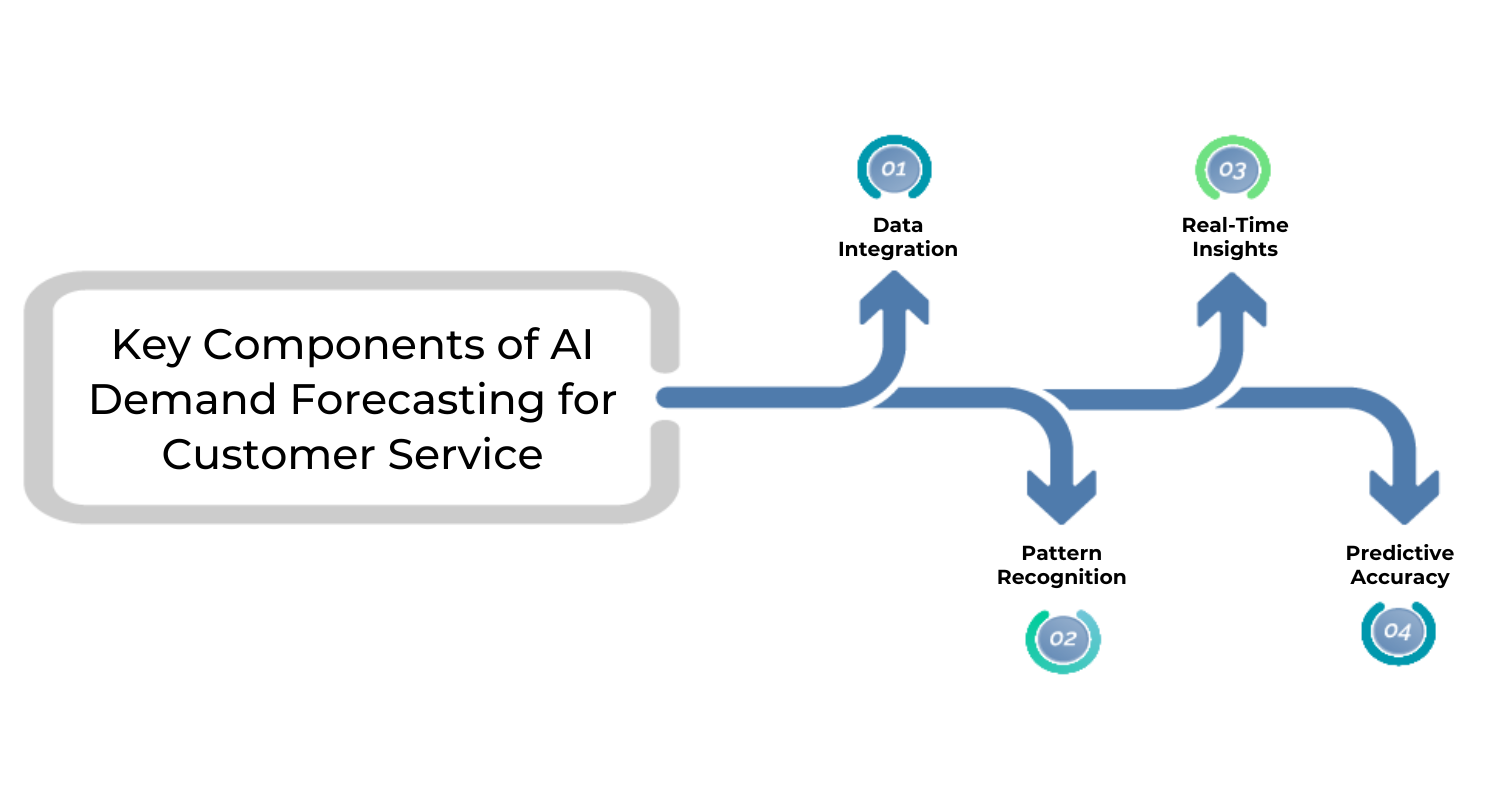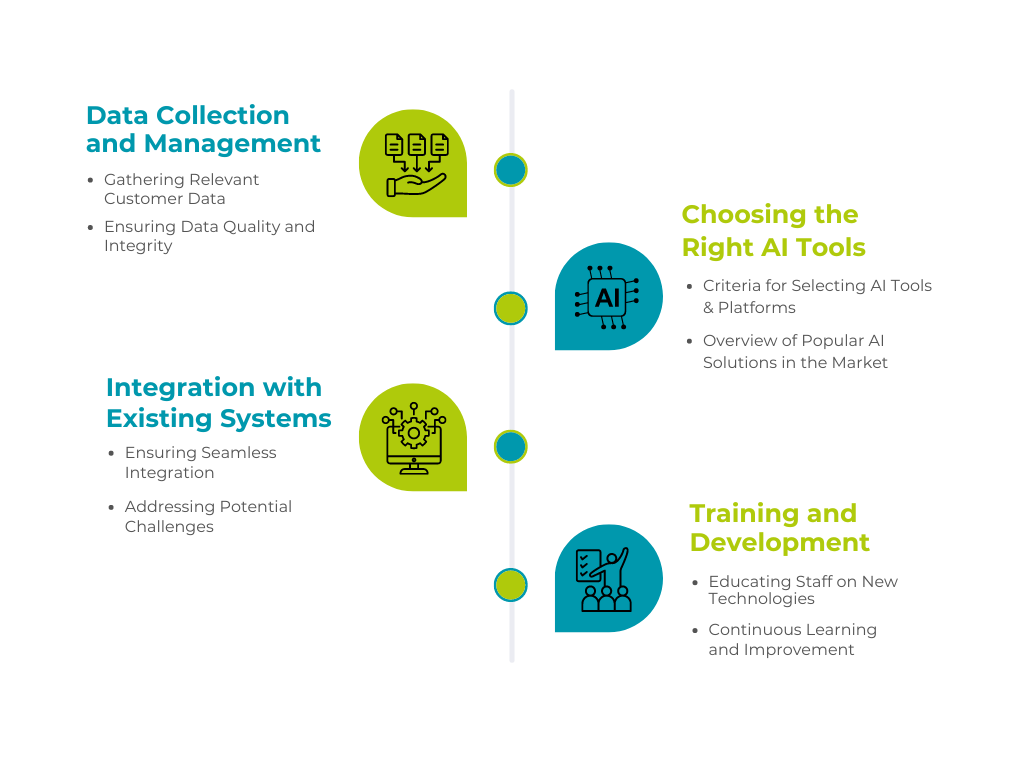
Demand forecasting is predicting future customer demand for products or services. It’s a critical business practice that enables companies to plan effectively, optimize inventory, allocate resources efficiently, and ultimately enhance customer satisfaction by meeting their needs promptly and accurately.
AI demand forecasting equips contact centers with the tools and insights to anticipate customer needs effectively, optimize operations, and deliver superior customer experiences. With AI, businesses can stay competitive in dynamic markets and foster long-term customer loyalty through responsive and efficient service delivery. Let’s discuss this in detail.
What is demand forecasting?
Demand forecasting in customer service involves predicting the number and type of support interactions customers request over a specific period. Using historical data and other relevant metrics, businesses can anticipate future contact volumes across various communication channels such as phone, chat, and email. It enables companies to plan and allocate resources efficiently, ensuring they have the right number of agents available to meet customer needs promptly.
Key Aspects of Demand Forecasting in Customer Service:

Historical Data Analysis:
- Utilizing past interaction data to identify patterns and trends in customer inquiries and issues.
Predictive Analytics:
- Applying statistical models and ML algorithms to forecast future contact volumes accurately.
Resource Allocation:
- Determining the optimal number of customer service agents needed to handle the projected contact volume, minimizing wait times, and improving service levels.
Channel Forecasting:
- Estimating contact volumes across different support channels (phone, chat, email) to ensure balanced resource distribution.
Operational Efficiency:
- Enhancing efficiency in workforce management, inventory control, and service delivery through accurate demand predictions.
Adaptability:
- Adapting to evolving customer behavior and market needs by continuously refining forecasts based on new data inputs.
Importance of Demand Forecasting in Customer Service
- Enhanced Customer Satisfaction: Businesses can provide timely and effective support by predicting customer needs and ensuring sufficient staffing, improving customer satisfaction and loyalty.
- Cost Optimization: Accurate demand forecasting helps minimize overstaffing or understaffing, thereby reducing labor costs and optimizing operational budgets.
- Strategic Planning: Informs decision-making related to resource allocation, capacity planning, and market entry strategies.
- Proactive Service Management: Enables contact centers to anticipate peak periods and prepare accordingly, reducing the likelihood of service disruptions and enhancing the overall customer experience.
The Role of AI in Demand Forecasting In Customer Service
AI demand forecasting in customer service leverages advanced technologies such as ML and deep learning to predict future customer demand for support services. This approach involves analyzing extensive amounts of data to recognize patterns and trends, enabling businesses to anticipate customer needs more accurately and efficiently.
Key Components of AI Demand Forecasting for Customer Service

Data Integration:
- AI collates data from various sources, including historical interaction data, market trends, digital footprints, social media activity, and online reviews. This approach ensures a complete understanding of customer behavior.
Pattern Recognition:
- Machine learning algorithms analyze the integrated data to recognize patterns and trends that traditional models might miss. It includes recognizing shifts in customer preferences, seasonal trends, and emerging issues.
Real-Time Insights:
- AI provides real-time analysis, allowing contact centers to make proactive adjustments based on the latest data. This shift from reactive to proactive management enhances the ability to meet customer demands promptly.
Predictive Accuracy:
- By leveraging AI, businesses can significantly improve the accuracy of their demand forecasts. AI’s ability to process and learn from new data continuously refines predictions, reducing forecasting errors and improving resource allocation.
Implementing AI Demand Forecasting In Customer Service

Accurate demand forecasting is more important now than ever. Leveraging artificial intelligence (AI) can significantly enhance the precision and efficiency of forecasting processes. Here are the essential steps and considerations for implementing AI demand forecasting in your organization.
Data Collection and Management
Gathering Relevant Customer Data:
Effective AI demand forecasting is based on the quality and breadth of data collected. Businesses should draw upon diverse data sources to acquire insights into consumer behavior, market trends, and external influences. Key data sources include:
- Historical Sales Data: Offers invaluable insights into past demand patterns and seasonal fluctuations.
- Market Trends: Provides context for evolving consumer preferences and competitor activities.
- External Factors: Economic indicators, weather patterns, and other external variables can influence demand dynamics.
Ensuring Data Quality and Integrity:
High-quality data ensures the forecasting models are built on a solid and dependable foundation. Implement various preprocessing techniques to refine and enhance datasets:
- Normalization: Scales numerical features uniformly, preventing biases and discrepancies in the model.
- Feature Engineering: Crafts or transforms new features to extract maximum predictive value from the data.
- Data Cleaning: Identifies and rectifies errors, inconsistencies, and missing values that could compromise the model’s integrity.
- Outlier Detection and Removal: Ensures the model remains robust and resilient against anomalies.
Choosing the Right AI Tools
Criteria for Selecting AI Tools and Platforms:
Choosing the right AI tools is crucial for successful demand forecasting. Consider the following criteria:
- Accuracy: The ability of the tool to provide precise forecasts.
- Scalability: The tool’s capacity to handle growing data volumes and increased processing requirements.
- Integration: How well the tool integrates with existing systems and data sources.
- User-Friendliness: Ease of use for non-technical staff.
Overview of Popular AI Solutions in the Market:
There are several AI tools and platforms available that cater to demand forecasting:
- IBM Watson: Known for its advanced machine learning capabilities and robust data integration features.
- Microsoft Azure Machine Learning: Offers a comprehensive suite of tools for building, training, and deploying machine learning models.
- Amazon Forecast: Provides highly accurate forecasts using machine learning and can easily integrate with other AWS services.
Integration with Existing Systems
Ensuring Seamless Integration:
For AI demand forecasting to be effective, it must seamlessly integrate with existing business systems and workflows. This involves:
- Data Integration: Ensuring the AI system can access and process data from various sources easily.
- System Compatibility: Verifying that the AI tools are compatible with current software and hardware infrastructures.
Addressing Potential Challenges:
Integration can come with challenges, such as data silos and legacy systems. Address these by:
- Developing a Clear Integration Strategy: Outline how the AI system will interact with existing processes and systems.
- Investing in Middleware Solutions: These can bridge gaps between disparate systems, facilitating smoother data flow.
Training and Development
Educating Staff on New Technologies:
Your team must be well-versed in the new technologies to leverage AI demand forecasting fully. This involves:
- Comprehensive Training Programs: Provide training sessions on how to use the new AI tools and interpret their outputs.
- Ongoing Support: Ensure staff access to continuous support and resources as they adapt to new systems.
Continuous Learning and Improvement:
AI and machine learning models require constant monitoring and optimization to maintain accuracy. Encourage a culture of continuous improvement by:
- Regular Performance Reviews: Regularly evaluate the AI model’s performance against real-world outcomes.
- Fine-tuning models: Adjust the models based on performance reviews and emerging data to ensure they remain accurate and relevant.
- Staying Updated on AI Advances: Keep abreast of the latest AI and machine learning developments to integrate new advancements and techniques into your forecasting process.
The Future of AI in Demand Forecasting for Customer Service
As we look to the future, the role of AI in demand forecasting is set to expand and evolve. Evolving technologies, such as advanced ML algorithms, real-time data processing, and enhanced predictive analytics, will continue to refine demand forecasting’s accuracy and efficiency. These innovations will further transform customer service, enabling businesses to provide even more personalized, proactive, and efficient support experiences.
Real-Time Predictive Analytics:
- Continuous data processing will allow for real-time adjustments in customer service strategies, ensuring businesses can swiftly respond to transforming customer needs and market dynamics.
Integration with IoT:
- IoT will contribute to richer datasets, providing new insights into customer behavior and enabling more precise demand forecasts.
Enhanced Personalization:
- AI-driven demand forecasting will enable personalized customer interactions tailored to individual preferences and historical behaviors.
Automated Decision-Making:
- AI will increasingly support automated decision-making processes, reducing manual intervention requirements and streamlining operations.
Advanced Sentiment Analysis:
- AI tools will incorporate advanced sentiment analysis, allowing businesses to gauge customer satisfaction and adjust their strategies accordingly.
Our advanced AI solutions at Vsynergize are designed to help businesses stay ahead in dynamic markets by anticipating customer needs with precision and efficiency. By leveraging our AI expertise, you can elevate your customer experience, optimize operations, and drive long-term customer loyalty.
Why Choose Vsynergize AI Solutions?
- Comprehensive Data Integration: Our AI systems seamlessly integrate with your existing data sources, ensuring a holistic view of customer behavior and market trends.
- Cutting-Edge Predictive Analytics: We employ state-of-the-art machine learning algorithms to deliver highly accurate demand forecasts, reducing errors and improving resource allocation.
- User-Friendly Tools: Our AI platforms are designed with ease of use in mind, enabling your team to harness the power of AI without the need for extensive technical knowledge.
- Scalable Solutions:With your growing business, our AI solutions can scale with you, effortlessly handling increasing data volumes and processing requirements.
- Ongoing Support and Training: We provide comprehensive training programs and continuous support to ensure your team can effectively leverage our AI tools.
With AI demand forecasting, businesses can experience operational efficiency and enhanced customer satisfaction. Stay ahead of the curve with Vsynergize, and ensure your customer service is proactive, responsive, and consistently exceeding expectations.



